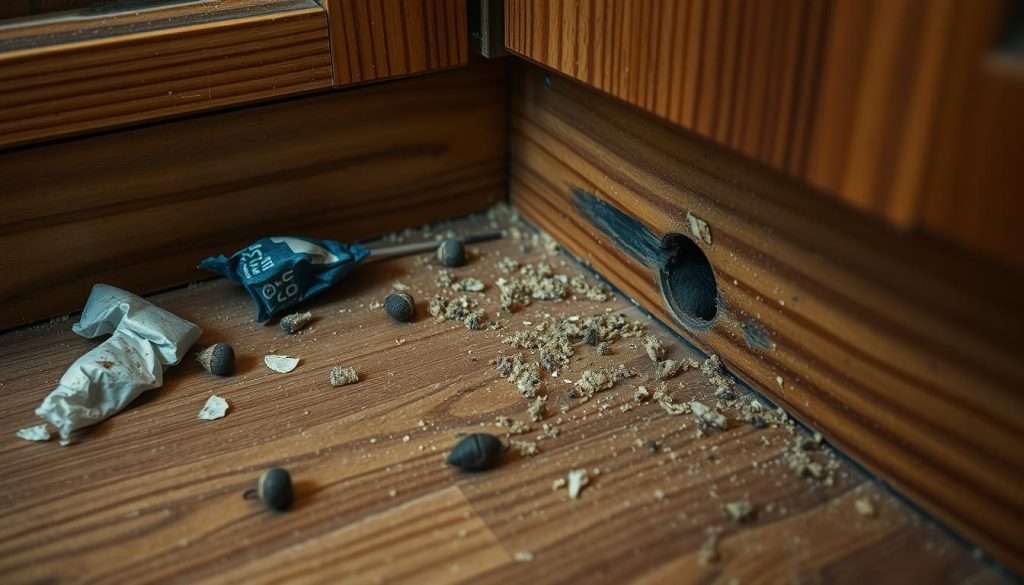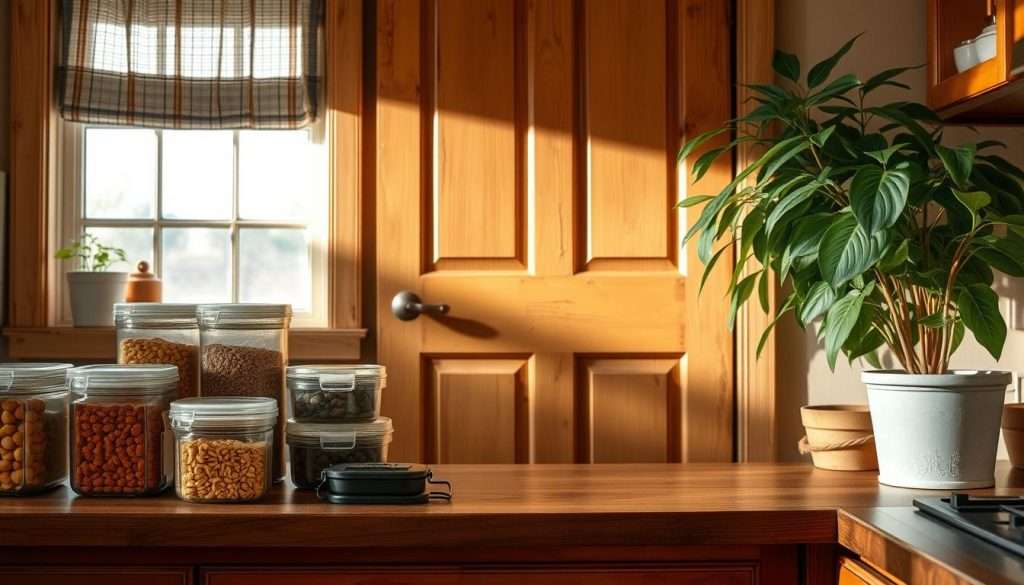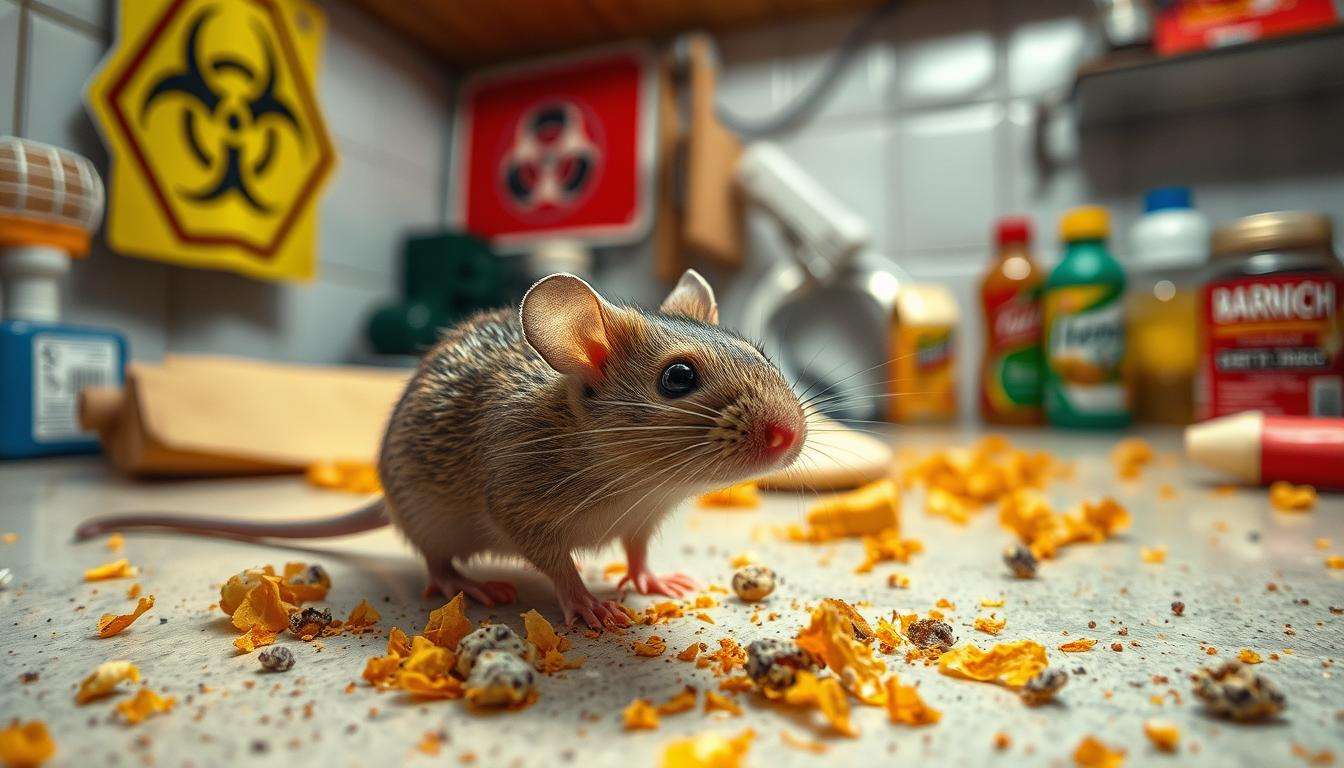Knowing if house mice are dangerous is key for homeowners. These small creatures can harm our health and homes. Mice can be good in nature, but in our homes, they’re a big problem.
They can have lots of babies, up to 35 a year. They also carry diseases and damage our homes. It’s important to keep our homes safe from mice.
Mice can spread serious diseases like hantavirus, which can be deadly. Homeowners need to know how to stop mice to keep their homes safe and healthy. Let’s learn more about house mice and why we need to act against them.
Key Takeaways
- Mice can reproduce quickly, with females having up to 35 babies each year.
- House mice pose health risks, including diseases like hantavirus.
- Identifying signs of an infestation is vital for early prevention.
- Keeping food areas clean helps in avoiding mouse attraction.
- Regular inspections can help spot vulnerabilities before mice invade.
Understanding House Mice: Characteristics and Habitat
House mice are interesting creatures. They have special house mice characteristics that help them live in many places. Knowing these traits helps us see how they make themselves at home, even in our houses.
Physical Description of House Mice
Adult house mice are 5.5 to 7 inches long, including their tails. Their tails are 2.75 to 4 inches long. They weigh between 0.5 to 1 ounce.
They come in different colors like grey, light brown, and black. Their belly is cream-colored. Their short hair hides their features, such as:
- Head and body length of 2.5 to 3.5 inches
- Hind feet measuring 15-19 mm long
- A run with a stride of about 4.5 cm
- Ability to jump vertically up to 45 cm
Their teeth grow all the time. This helps them find food and shelter. They can even get into homes through small cracks or openings bigger than 1/4 inch.
Typical Habitats and Nesting Behavior
Learning about mouse habitats tells us a lot about their lives. House mice are active at night. They like dark, quiet places.
- Walls
- Attics
- Crawl spaces
They nest in warm, safe spots, especially when it’s cold. A group usually has one male and several females. Their territory is about 4-5 feet, depending on food and water.
House mice do well in both nature and cities. The places they live affect their diet, social life, and how they nest. They eat plants, seeds, and insects, fitting into many mouse habitats.
To learn more about house mice, check out this detailed overview. It shows their amazing adaptations and behaviors.
Health Risks Associated with House Mice
House mice might look harmless, but they can be very dangerous. They carry diseases that can harm humans. It’s important to know about these diseases to keep your home safe.
The dangers come from touching mice or their waste. Mouse droppings are a big problem. We will look at some diseases mice can spread.
Diseases Transmitted by House Mice
House mice carry many diseases. These can spread through their droppings, urine, or saliva. Here are some diseases to watch out for:
- Salmonellosis: This disease comes from mice touching food and surfaces. It can cause cramps, fever, and diarrhea.
- Hantavirus: This rare disease can be deadly. It spreads through mouse droppings and urine. Symptoms include feeling tired, fever, and breathing problems.
- Lymphocytic Choriomeningitis (LCM): This disease can be very serious, especially for pregnant women. It can cause flu-like symptoms or brain problems.
- Rat Bite Fever (RBF): This disease comes from mouse bites or scratches. It can cause fever and joint pain.
Potential Effects of Mouse Droppings on Health
Mouse droppings are a big health risk. They can make you very sick. Here are some dangers:
- Contamination: Mouse droppings can make food, surfaces, and items dirty. This can lead to salmonellosis and other illnesses.
- Airborne Risks: When mouse droppings are disturbed, they can spread diseases in the air. This makes it easy to breathe in harmful stuff.
- Parasite Transmission: Mice can carry parasites. These can cause toxoplasmosis, another health problem.
To stay safe, keep your home clean. If you see mice, act fast. Taking steps to prevent mouse problems can help keep you and your family healthy.
Are House Mice Dangerous: Evaluating the Risks
It’s important to know the dangers of house mice. Mouse bites are often overlooked. Mice usually stay away from people but can bite when scared. This can lead to infection risks.
This section looks at the dangers of mouse bites. It also talks about the risks of having mice in your home.
Mouse Bite Dangers and Infection Risks
Mouse bites might seem small but can be serious. Mice carry diseases that can harm humans. When they bite, they can spread bacteria into the wound.
This can lead to infections. In some cases, diseases from mice can make people very sick.
Mouse Infestation Risks to Home Safety
Mouse infestations are a big problem in homes. The National Pest Management Association says rodents invade 21 million homes each winter. Mice can get into homes through tiny openings, like a nickel.
Mouse droppings can spread allergens and diseases. They also chew on things like insulation and wires. This can cause fires and make homes unsafe.
Seeing one mouse means there are more. It’s key to deal with mouse problems quickly to keep your home safe.
Signs of a Mouse Infestation
It’s important for homeowners to know the signs of a mouse infestation. This helps keep your home safe and healthy. Look for common signs that show a mouse problem.
Identifying Mouse Droppings and Gnaw Marks
Mouse droppings are a clear sign of an infestation. They look like dark grains of rice, about 1/8 to 1/4 inch long. In bad cases, you might see 50 to 80 droppings a night.
Look for droppings in kitchens, bathrooms, or along walls. Also, check for gnawed holes in food or items. And look for nests made from shredded paper or fabric.
Gnaw marks show mice are active. They make small holes and leave grease marks or urine pillars. Mouse urine smells like ammonia and stains yellow, showing a problem.
Other Indicators of a Mouse Presence
Other signs can also show mice are around. Watch for:
- Visible tracks on dusty surfaces, especially in attics or basements.
- Puddles of urine near nests.
- Unusual scratching noises at night, since mice are active then.
- Musky smells near nests.
Looking for droppings, gnaw marks, and other signs helps spot and solve mouse problems early.

Controlling Mouse Population: Effective Strategies
To keep your home mouse-free, you need to act early and often. Use a mix of ways to keep them out and catch them. Here are some tips to help you keep your home safe from mice.
Exclusion Techniques to Prevent Entry
Stopping mice from getting into your home is key. Seal all entry points to limit their access. Here are some ways to do it:
- Check and seal gaps in walls, doors, and windows. Use caulk for small holes and steel wool for big ones.
- Put door sweeps and window screens on to block entryways.
- Keep outdoor areas clean by cutting back bushes and removing debris that mice might hide in.
- Store firewood away from your home and keep it off the ground.
Trapping and Preferential Baiting
If mice are already in your home, trapping them is crucial. Use their habits to catch them. Here’s how:
- Set snap traps where you see mouse signs like droppings or gnaw marks.
- Use bait like peanut butter or sunflower seeds that mice like.
- Use many traps in key spots to catch more mice.
- Choose single-dose or multiple-dose rodenticides carefully. Get help from a pro for safe use.
Combining cleaning with trapping mice is a strong plan. Keep food sealed and manage waste well to avoid attracting mice. These steps will help you keep your home mouse-free.
| Strategy Type | Description | Effectiveness |
|---|---|---|
| Exclusion Techniques | Sealing entry points to prevent access. | High |
| Trapping | Using snap traps and bait to capture mice. | Moderate to High |
| Rodenticides | Utilizing poisons with professional guidance. | Variable; requires caution |
| Sanitation | Maintaining cleanliness to deter mouse attraction. | High |
Tips for Mouse Prevention at Home
To stop mice, keep your home clean and secure. Use good mouse prevention tips. This helps keep your home healthy and mouse-free.
Keeping Food Storage Areas Clean and Sealed
Keeping food areas clean is key to stopping mice. They love easy food, so make sure your food is safe. Here’s how:
- Use airtight containers for food to keep it fresh.
- Clean food prep areas often to remove crumbs and spills.
- Throw away trash right and use bins with tight lids.
- Check and clean your pantry and other food spots often.
Regular Home Inspections for Vulnerabilities
Checking your home often is important. It helps find and fix mouse entry points. Here’s what to do:
- Look for small gaps, like around pipes and vents; mice can squeeze through tiny spaces.
- Check your walls and foundation for cracks and seal them fast.
- Keep your yard clean to avoid mice hiding spots.
- Get experts to inspect your home, especially hidden spots.

Following these tips helps protect your food and home. Regular checks are key to keeping mice away. Stay alert to keep your home safe.
Conclusion
Knowing the dangers of house mice is key to a safe home. They can spread diseases like Salmonella and cause allergies that make asthma worse. Since they can get in through tiny cracks, stopping them is very important.
To keep your home safe, you need to act fast. Seal up holes, keep food tight, and check for mice often. A single mouse can leave droppings that are a quarter inch long. This shows how important it is to watch out for them.
By following these steps, you can lower the risks of house mice. We can all make our homes healthier and safer. Let’s stay alert and keep our homes pest-free.
